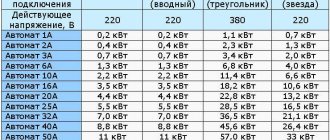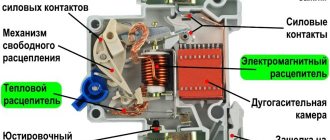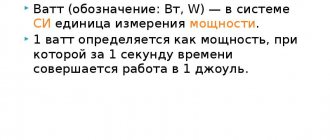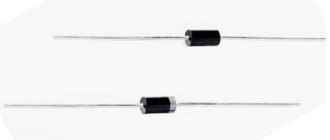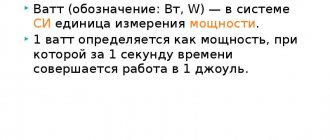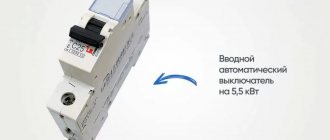Amps and kilowatts are the main characteristics of electricity. Amperes are also called load, and kilowatts are called power. The need to convert these units from one to another arises when you need to understand which protective relay can be installed in an electrical circuit so as not to damage the device connected to it.
The material presented below provides specific examples and calculation formulas for different types of electrical networks and explanations for carrying out such calculations.
If we look at the labeling of most devices that operate from the mains, then the designation of the characteristics of the device usually indicates only the current strength, that is, the value in amperes. But there is also current power, which is measured in kilowatts. And this indicator is especially important when you need to select a protective network device that is installed in the electrical network. The correct choice of an automatic relay allows you to protect devices connected to the network from failure due to peak voltage loads, and the network wires from fire. We will consider the theory and examples of such calculations below.
The need to convert amperes to kilowatts
Power and current are two main characteristics that you need to know in order to correctly install protective devices when working with electrical devices connected to the network. Each device connected to the network must be protected by individually selected protective devices . At the same time, electrical wiring may melt and catch fire if the protective devices are not selected correctly and do not comply with the technical characteristics of the network. After all, all electrical wires that are used have their own current-carrying capacity, which depends on the cross-section of the wire core, and the material from which these cores are made must be taken into account.
Protective devices are usually triggered by voltage surges, which can damage devices connected to the network at that moment. To prevent this from happening, the protection must turn off the branch to which low-power devices are connected. But the relay only indicates the current strength in amperes. And the electrical appliances that we connect to the network are marked with power consumption in watts and kilowatts. The relationship between power and current is very close.
To understand this, you need to understand the terminology and operating principles of the electrical network.
- Usually we consider network voltage , which represents the potential difference, that is, the work that occurs when an electric charge moves from one point in the electrical network to another. The voltage in any electrical network is indicated in volts.
- Current strength , which is measured in amperes, is the number of amperes passing through a conductor in a certain unit of time.
- Current power is the speed at which a charge moves through a conductor and is measured in watts or kilowatts.
Characteristics of a three-phase system
Reactive power
A three-phase power supply system is characterized by several voltage and current values. It all depends on between which points of the circuit the measurements are made:
- between the phase wire and the neutral – phase voltage Uph;
- between individual phases – linear Ul.
The relationship between these parameters:
Ul=√3∙Uф.
With symmetrical load distribution, the currents in all wires are equal. In a four-wire circuit (with a grounded zero), there is no current in the neutral conductor, so even if the zero is broken, the network continues to function normally.
In the case where the energy consumption differs between phases, some current flows in the neutral wire. A complete break in the neutral conductor causes a phase imbalance, so the voltage on the wires can change in the range from zero to linear.
Consequences of increasing neutral resistance
The reactive nature of the load is taken into account by the power factor cosϕ. This value comes from the theory of complex numbers, which are used when it is necessary to calculate the parameters of alternating current circuits. In the case of an active load, cosϕ = 1, but the more reactive the consumers are, the more the coefficient decreases, showing how the real power decreases relative to the total.
Important! Therefore, to correctly calculate and reduce the load on generating equipment, power factor correctors are installed in reactive circuits. Circuits with a corrector bring the cosϕ coefficient closer to unity
Unit conversion rules
In the instructions for many devices there are designations in volt-amperes. Their distinction is necessary only for specialists for whom these nuances are important professionally, but for ordinary consumers this is not so important, because the designations used in this case characterize almost the same thing. As for kilowatt/hour and just kilowatt, these are two different quantities that should not be confused under any circumstances.
To determine electrical power through the network current indicator, you can use various tools with which measurements and calculations are made:
- using a tester;
- using clamp meters;
- making calculations on a calculator;
- using special reference books.
Using a tester, we measure the voltage in the electrical network we are interested in, and then use a current clamp to determine the current strength. Having obtained the necessary indicators and applying the existing formula for calculating direct and alternating current, you can calculate the power. We divide the existing result in watts by 1000 and get the number of kilowatts.
Single phase electrical circuit
Basically, all household electrical networks are single-phase networks that use a voltage of 220 volts. The load marking for them is written in kilowatts, and the current strength is in amperes and is designated as AB.
To convert one unit to another, the formula of Ohm's law is used, which states that power ( P ) is equal to current ( I) multiplied by voltage ( U ). That is, the calculation will look like this:
How to find the power of a three-phase network by current and voltage, calculation using formulas
Three-phase and single-phase networks are distributed approximately equally in private and apartment buildings. But it is worth noting that the industrial network is three-phase by default and in most cases a three-phase network is suitable for the street where private houses are located or for an apartment building. And only then it is branched into three single-phase ones, and brought to the final current consumer.
The calculation was made for a reason, but with the goal of ensuring the most efficient transfer of electricity from the power plant to you, and also the goal of the greatest reduction in electricity losses in the transportation process is pursued, because the current is resisted by the conductor through which this same current flows.
If you are wondering what kind of network you have in your house or apartment, then determining this is quite simple. If you open the electrical panel and look at how many wires are used for your apartment, then if you see 2 or 3 wires , this is a single-phase network, 1 and 2 wires are phase and neutral, 3 wire, if present, is grounding. In a three-phase network of wires there will be either 4 or 5. Three phases A, B, C, zero and, if present, a grounding conductor.
The number of phases is also determined by the so-called package, the input circuit breaker. For a single-phase network, 2 or 1 double cable is allocated, and in a three-phase network there will be 1 triple cable and a single one. But we should not forget about voltage, which you need to be very careful with.
In order to calculate by current and calculate by voltage to find out the power, it is not difficult, as a rule, three-phase networks require large energy consumers. Using the formula given in the article, you can easily calculate power using current and voltage values.
Find out the power consumption of electricity
So, let's get to the point, we need to find out the power of electricity by current and voltage. First of all, you need to know how much energy you will consume. This is easy to find out by comparing all the energy consumers in your home.
Let's choose the most common technique that modern people cannot do without. By the way, you can find out how much a particular device consumes in the passport data of your electrical device, or on a tag that may be on the case.
Let's start with the highest voltage consumption:
- Washing machine - 2700 Watt
- Water heater (boiler) - 2000 Watt
- Iron - 1875 Watt
- Coffee maker – 1200 Watt
- Vacuum cleaner – 1000 Watt
- Microwave - 800 Watt
- Computer – 500 Watt
- Lighting – 500 Watt
- Refrigerator - 300 Watt
- TV - 100 Watt
According to the formula, we need to add everything and divide by 1000 to convert from watts to kilowatts.
In total, we got 10975 watts, let's convert it to kilowatts, dividing by 1000.
Our total consumption is 10.9 kW.
For the average person, one phase is quite enough. Especially if you are not going to turn everything on at the same time, which is, of course, unlikely.
But you need to remember that current consumption can be significantly higher, especially if you live in a private house and/or have a garage, then the consumption of one device can be 4-5 kW. Then you will prefer a three-phase network, as it is more powerful and allows you to connect significantly more powerful current consumers.
Three-phase network
Let's take a closer look at the three-phase network, as it is more preferable for us. To begin with, we give a comparative description of a single-phase and three-phase network. Let's highlight some pros and cons.
When a three-phase network is used, there is a possibility that the load will be distributed unevenly across each phase. If, for example, an electric boiler and a powerful heater are powered from the first phase, and a TV and refrigerator are powered from the second, then a phenomenon such as “phase imbalance” will occur - voltage and current asymmetry, which may be a consequence of the failure of some current consumers. To avoid such a situation, load distribution should be carefully planned at the initial stage of network design.
Also, a three-phase network will require a larger number of wires , cables and circuit breakers that carry current, since the power will be much higher, and therefore the installation of such a network will be more expensive.
A single-phase network is inferior to a three-phase network in terms of possible potential power. So if you expect to use a lot of powerful current consumers, then the second option will be correspondingly better. For example, if a two-wire (three-wire if it is grounded) cable with a cross-section of 16 mm2 comes into a house from a power line, then the total power of all electrical consumers in the house should not exceed 14 kW, as in the example above.
But if you use the same wire cross-section for a three-phase network, but accordingly the cable will have 4-5 cores , then even then the maximum total power will already be 42 kW.
We calculate the power of a three-phase network
For the calculation, we will take a certain production workshop in which thirty electric motors . A four-wire line enters the workshop, remember that these are 3 phases: A, B, C, and neutral (zero). Rated voltage 380/220 volts. The total power of all engines is Ru1 - 48 kW, we also have lighting lamps in the workshop, the total power of which is Ru2 - 2 kW.
- Ru - the installed total power of a group of consumers, equal in value to the sum of their declared capacities, measured in kW.
- Kc is the demand coefficient at the highest load mode. The demand factor takes into account the largest possible number of activations of the group's receivers. For electric motors, the demand factor must take into account their load.
The demand coefficient for the lighting (lighting) load, that is, lighting, is Ks2-0.9, and for the power load, that is, electric motors, Ks1 = 0.35. Average power factor for all consumers cos(φ) = 0.75. It is necessary to find the calculated line current .
Conclusion
If we return to a single-phase 220V network, then there is a rule that 1 kW is equal to 4.54A, that is, 1A = 0.22 kW or 220V.
As can be seen from the above formulas and calculations, Ohm’s law is used throughout the calculations, where the electric current is the inverse of the resistance. Knowing now all the formulas necessary for calculations, you can independently carry out the necessary actions to select the automatic relay you need to connect, which can be included in the electrical network with the guarantee that all devices connected to it will be safe.
How to calculate?
The calculation of the power of a three-phase network is calculated as follows: I=P/U. This is the most primitive formula used in schools.
The general calculation is based on the following notation: Ptot = Uа∙Iа∙cosа+ Ub∙Ib∙cosb+ Uc∙Ic∙cosc. Here cos denotes changes in P, and the letters next to it are the very phases that run next to the lines.
Three-phase or single-phase connection
Depending on what type of connection is used, the power consumption is determined differently.
In a single-phase network, the energy consumed is calculated using the simplest formula:
P=U∙I∙cosϕ,
where cosϕ is the power factor characterizing the phase shift between current and voltage in a reactive load.
The power of a 3-phase network is the sum of consumption for each phase separately. The power formula for 3-phase current is as follows:
Ptotal=Uа∙Iа∙cosϕа+ Ub∙Ib∙cosϕb+ Uc∙Ic∙cosϕc,
where U, I, cosϕ are voltage, current and power factor in each phase, respectively.
For your information. It can be seen that in the general case, a three-phase connection requires a larger number of metering devices.
Sometimes you can calculate energy consumption using a simplified version. With symmetrical consumption, for example, when connecting an asynchronous motor, the consumption currents are the same, and the formula takes the following form:
P=3Uф∙Iф∙cosϕ=√3Uл∙Iл∙cosϕ,
Where:
- Uph, Iph – phase voltage and current;
- Ul, Il – linear voltage and current.
Asynchronous motor
